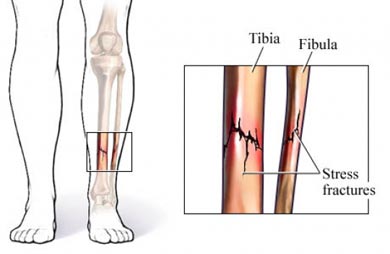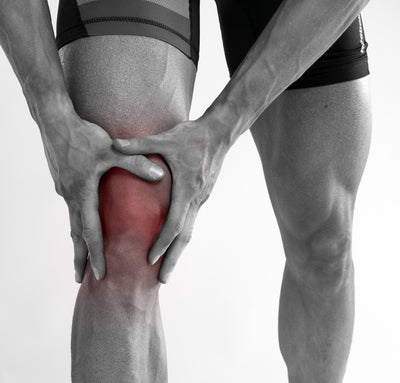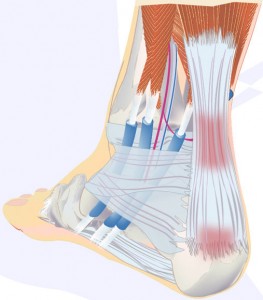Common Overuse Injuries and Tendinopathies
Endurance athletes alternate periods of intensive physical training with periods of rest and recovery. An imbalance caused by overly intensive training and inadequate recovery leads to a breakdown of cellular reparative mechanisms and eventual tissue breakdown. Physicians have historically referred to overuse injuries of tendons as “tendinitis,” suggesting that the underlying process is inflammatory.
STRESS FRACTURE

Stress fracture is a common and potentially serious overuse injury in endurance athletes. Stress fracture develops when bone is subjected to repetitive loading (e.g., during running). Microtrauma of the bone accumulates, and bone remodeling cannot keep pace with the continued mechanical stress. Stress fracture should be considered whenever an endurance athlete—particularly a runner—presents with focal musculoskeletal pain. Stress fracture is suggested clinically when physical examination reveals significant tenderness over a bony structure.
In many cases, stress fractures simply require relative rest and, possibly, short-term use of crutches or a walking boot. Patients with metatarsal fractures may be treated with a postoperative sandal or stiff-soled shoe. Some studies have shown that the use of shock-absorbing inserts in footwear may reduce metatarsal stress fractures.
PATELLOFEMORAL PAIN SYNDROME

Patellofemoral pain syndrome, often referred to as “runner's knee,” is a generic descriptor for anterior knee pain related to a spectrum of patellofemoral joint disorders. Athletes typically describe pain in the anterior knee that is related to repetitive loading of the joint while running, jumping, or cycling; that is aggravated by climbing or descending stairs or hills; and that is aggravated by prolonged sitting with the knees flexed
As with most overuse injuries, modification of the training schedule is useful. For example, cyclists may need to adjust their saddle height, cycling position, or pedal/cleat system. Other potential treatment strategies include rehabilitative exercises, icing, taping or the use of orthotic devices.
ACHILLES TENDINOPATHY

The usual history of Achilles tendinopathy is a gradual and insidious onset of pain in the Achilles tendon. In mild cases, symptoms may be present only during exercise, whereas in more severe cases, the pain will interfere with normal daily activities. Although initial treatment may include activity modification, temporary use of a walking boot in severe cases, heel lifts, gentle stretching, icing, and NSAIDs, the most effective treatment is an eccentric strength training program.
PLANTAR FASCIITIS
Plantar fasciitis is thought to result from microscopic tearing of the plantar fascia secondary to traction and overuse. Athletes describe heel or arch pain that often is worse upon the first few steps in the morning or after prolonged sitting. Appropriate recovery strategies include relative rest, heel cord and plantar fascia stretching, icing, NSAIDs, prefabricated shoe inserts to provide arch support, and avoidance of flat shoes or going barefoot. In one prospective study, silicone inserts were more helpful than rubber heel cups, and both were more helpful than custom orthotics. Surgery with or without calcaneal spur excision should be reserved for patients with refractory symptoms of more than six to 12 months' duration who fail nonoperative treatment.
By DAVID D. COSCA and FRANCO NAVAZIO (July 2007)
